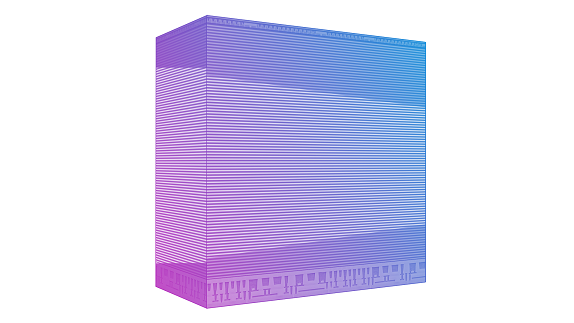Micron Shipping 176-layer 3D NAND, With Enterprise Storage, Other Apps To Come
‘The ability to store upwards of 20 to 30 hours of HD video on what equates to the size of a pinky fingernail is what you can do with our 176-layer technology. Additionally, the capability exists to stack those die on top of each other all the way up to 16 of those die, and putting those 16 die into essentially the thickness of the entire pinky itself,’ says Derek Dicker, corporate vice president and general manager for Micron’s Storage Business Unit.

Micron Technology on Monday unveiled what it terms the world’s first 176-layer 3D NAND flash memory, and said that the technology is already shipping in its Crucial line of consumer SSDs and that enterprise SSDs with the technology are on the way.
Micron has been in the NAND industry for over 15 years, and is currently on its fifth generation of 3D NAND technology and in its second generation of replacement gate NAND, said Derek Dicker, corporate vice president and general manager for Boise, Idaho-based Micron Technology’s Storage Business Unit.
Dicker, speaking at a press and analyst briefing Monday morning, said the NAND business still has a long way to grow. He said that, between 2019 and 2023, the NAND industry and Micron are estimating NAND demand for SSDs will grow at a cumulative annual growth rate of 30 percent.
[Related: Intel’s $9B NAND SSD, Memory Sale To SK Hynix: 6 Big Things To Know]
“And in a scary way of looking at numbers, we‘re looking at almost a trillion gigabytes forecast in 2023. ... We believe that the secular trends behind NAND and the future associated with NAND is incredibly bright,” he said.
Micron on Monday unveiled what it calls the industry‘s first 176-layer triple-level cell NAND.
“We‘re particularly proud of what we believe is a breakthrough in both memory performance and density,” Dicker said.
The development of 176-layer NAND means an approximately 40-percent increase in layer count than that of the nearest competitors, in particular the 128-layer NAND currently available in the market today, Dicker said.
At the same time, Micron has been able to shrink the die size of the new NAND by about 30 percent compared to the industry‘s current best-in-class die size, he said.
Micron‘s new 176-layer NAND also has a 35-percent-plus improvement in both write latency and read latency, compared to Micron’s high-volume floating point gate NAND on 96-layer NAND, he said.
Finally, the new NAND has a 33-percent faster data transfer rate, Dicker said.
“And that essentially translates to a larger, we‘ll call it if you will, pipe into the NAND device that’s capable of operating at 1,600 mega transfers per second [compared] to our 96-layer NAND product,” he said.
All of these claims are noteworthy, Dicker said.
“But the incremental dynamic that we think is maybe even the most noteworthy is the fact that today we‘re in volume production with this 176-layer NAND, shipping SSD product to customers under the Crucial brand,” he said.
The new 176-layer NAND includes Micron‘s stacked replacement gate NAND architecture.
According to Micron, the company’s replacement-gate architecture uses highly conductive metal for the wordlines instead of a polysilicon layer for the wordlines to increase 3D NAND performance. Wordlines are connecting wires to the gate of each NAND memory storage element in a NAND memory array, and are used to select, program, and erase groups of memory cells in an array of NAND memory.
With this architecture, Micron places two 88-layer NAND stacks, one on top of the other, Dicker said. “And that essentially allows for efficiency of design as well as time to market advantages,” he said.
It also features Micron‘s CMOS under the Array technology, which combines the NAND memory with the CMOS logic needed to access the memory as part of the NAND as a way to compress the die size, he said.
Density of the new technology is quite high, Dicker said. A new Micron 176-layer 3D NAND die is about one-fifth the thickness of a piece of paper, he said.
“The ability to store upwards of 20 to 30 hours of HD video on what equates to the size of a pinky fingernail is what you can do with our 176-layer technology,” he said. ”Additionally, the capability exists to stack those die on top of each other all the way up to 16 of those die, and putting those 16 die into essentially the thickness of the entire pinky itself.”
Initial end applications for 176-layer NAND will be found in cloud and data center infrastructures to improve performance and quality of service; edge devices including IoT, smart manufacturing, and new applications such as automobiles; and mobile devices, particularly as the transition to 5G continues with its promise of data rate improvements of up to 20 times and latency reductions of 10 times compared to earlier technologies, Dicker said.
Micron‘s 176-layer NAND is shipping starting Monday in the company’s Crucial line of consumer-focused SSDs.
Dicker declined to discuss which OEM SSD manufactures if any will use Micron‘s 176-layer NAND technology.
“But what I can say is that we do have plans to deliver both client and data center SSDs into the account base over time, but no specific announcements today,” he said. ”And of course, into mobile phones and automobiles.”
Dicker also declined to compare Micron‘s 176-layer NAND technology compared to the latest technology from specific competitors, but he did say the die size is 30-percent the size of competitive die sizes. He also said that 128-layer NAND is currently the technology in production by Micron’s competitors.